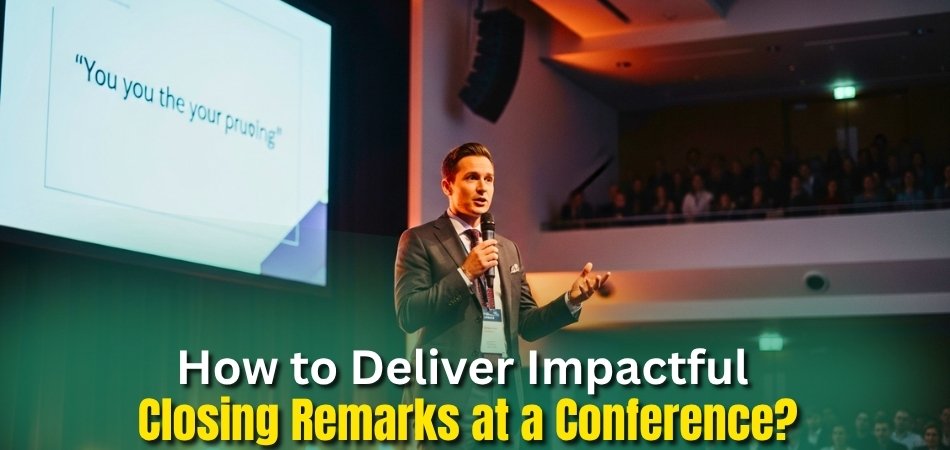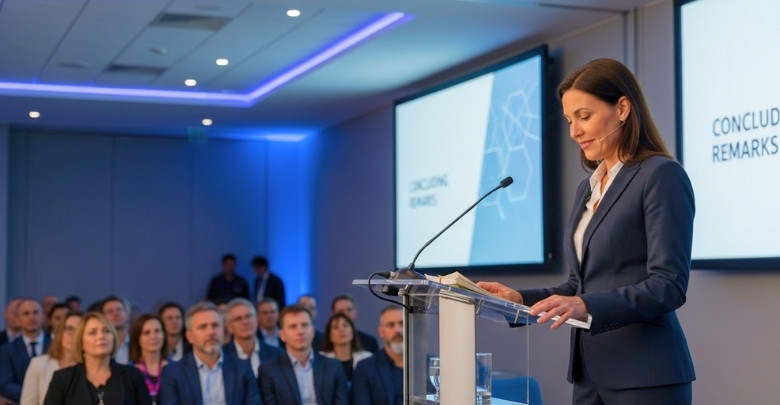Have you ever attended a conference where the final speech stayed with you long after the event ended? That’s the power of a well-delivered closing remark; it can inspire, connect, and leave the audience reflecting on shared ideas. Great closing words often define how an event is remembered.
So, how to deliver impactful closing remarks at a conference? The answer lies in balancing gratitude, reflection, and inspiration. A good closing remark acknowledges key contributors, summarizes the event’s highlights, and ends with a message that motivates the audience to take something valuable forward.
Your final words are more than a conclusion; they’re a bridge between experience and action. Continue reading to discover practical steps and examples that will help you craft memorable, meaningful closing remarks for any conference.
How to Deliver Impactful Closing Remarks at a Conference?
A conference’s final words often shape how the entire event is remembered. Closing remarks are not just a formality but a reflection of appreciation, insight, and inspiration. When delivered well, they leave the audience with motivation and a sense of shared accomplishment.
For instance, global events like upcoming conferences in Canada, the USA, or the UK often highlight how a powerful conclusion inspires attendees to return year after year. Let’s walk through the key steps that make closing remarks impactful and memorable.

Start with Greetings and Gratitude
Begin by acknowledging everyone who contributed to the event’s success. Express sincere appreciation to organizers, speakers, and attendees for their time and effort. This sets a warm tone and helps you connect instantly with the audience, making them feel recognized and valued at the end of the event.
Recap Key Conference Highlights
Briefly summarize the main takeaways, themes, or sessions that stood out during the conference. Mention key insights or memorable quotes that reinforce the event’s overall purpose. A short and focused recap reminds participants of what they gained and why their involvement was meaningful.
Acknowledge Contributors
Recognize the behind-the-scenes individuals, such as volunteers, sponsors, or technical teams, who made the event possible. Personal acknowledgment builds goodwill and strengthens community spirit. Mentioning specific names or departments can make this gesture feel genuine and heartfelt.
Include a Final Message or Call to Action
Encourage participants to take what they learned and apply it in their professional or academic journey. A motivational message ensures your closing doesn’t just end the event but extends its influence beyond the venue. Inspire them to stay connected or look forward to future conferences.
End with a Memorable Closing Line
Finish with a thoughtful and memorable sentence that leaves a lasting impression. You can use a powerful quote, a reflective statement, or a hopeful line that captures the conference’s vision. The closing line should evoke emotion and leave attendees inspired as they head back to their routines.
Sample Outline for a Closing Remark
“Good evening everyone,
As we come to the close of this inspiring conference, I’d like to take a moment to thank our speakers, organizers, and participants for making this event a success. The ideas shared here will continue to guide us forward. Let’s carry the spirit of collaboration into our next ventures together.”
Delivering effective closing remarks is about balance—gratitude, reflection, and inspiration in equal measure. When your final words align with the event’s purpose and emotions, they leave an impression that lasts well beyond the applause.
The Real Purpose Behind Closing Remarks
Closing remarks are more than just a polite conclusion to an event. When delivered with purpose, they tie the entire conference together, leaving attendees with a sense of fulfillment and direction as they prepare to apply what they’ve learned. These essential elements of conference closing remarks make your message truly memorable. Take a look at the real purpose of closing remarks to deliver messages that resonate long after the event ends.
Reinforcing the Conference’s Key Theme or Message
A strong closing remark circles back to the event’s main theme. It highlights the central ideas discussed throughout the sessions and reminds attendees of the conference’s broader mission. This reinforcement ensures that participants leave with a clear understanding of what the event aimed to achieve.
Showing Gratitude and Unity
Closing remarks offer an opportunity to thank everyone who contributed to the event’s success. Acknowledging both the visible and behind-the-scenes contributors builds a sense of unity. When appreciation is expressed sincerely, it strengthens relationships among organizers, speakers, and participants, fostering a shared sense of achievement.
Motivating Future Participation or Collaboration
An impactful ending motivates attendees to stay engaged beyond the event. Encourage participants to apply the knowledge they’ve gained, collaborate with peers, or join future editions of the conference. This forward-looking message turns a one-time event into an ongoing journey of learning and connection.
Reflecting the Event’s Tone and Vision
Every conference has its own personality, and the closing remarks should reflect that tone. Whether the event is academic, professional, or creative, your final words should match its energy and values. This consistency helps preserve the spirit of the conference and leaves a lasting emotional imprint on the audience.
The real purpose of closing remarks lies in tying every element of the conference together—gratitude, reflection, and inspiration. When aligned with the event’s tone and vision, these final words transform a routine ending into a memorable conclusion that motivates continued engagement.
How to Maintain Confidence While Concluding?
Confidence plays a major role in how your audience perceives your closing remarks. Even the best-written speech can lose its impact if delivered without poise and control. Staying confident helps you communicate clearly, manage nerves, and leave a strong impression during the final moments of your presentation. Let’s look at practical ways to stay composed and confident while concluding your conference speech.
Tips for Staying Composed Under Pressure
Take a deep breath before stepping on stage and focus on the message rather than yourself. Remember, the audience wants you to succeed. Keeping eye contact and smiling naturally can instantly calm your nerves. Visualizing a positive outcome helps replace anxiety with assurance and a sense of control.
Importance of Rehearsal and Preparation
Confidence grows from familiarity. Practice your speech multiple times to master transitions and timing. Rehearse aloud, ideally in front of a trusted friend or mirror, to spot areas needing refinement. Preparation not only improves flow but also minimizes hesitation, helping you appear more relaxed and in command.
Managing Body Language, Pace, and Breathing
Your physical presence often speaks louder than words. Maintain an open posture, move purposefully, and avoid fidgeting. Speak slowly enough for clarity but with enough energy to keep attention. Controlled breathing supports vocal stability, allowing your tone to stay even and engaging throughout the closing.
Handling Unexpected Issues Gracefully
Technical problems, time overruns, or distractions may arise unexpectedly. Instead of panicking, pause briefly and acknowledge the issue calmly. A confident smile or light comment can defuse tension. Your composure under such moments demonstrates professionalism and reassures the audience that you’re in control.
Quick Confidence Boosters Before Going on Stage
- Breathe deeply: Take three slow breaths to settle nerves.
- Visualize success: Picture yourself finishing strong and receiving applause.
- Smile intentionally: A simple smile helps project warmth and relaxes your body naturally.
Confidence during your conclusion reflects not just your preparation but your mindset. By practicing consistently, controlling your pace, and staying centered under pressure, you can close your conference speech with strength and authenticity that resonates with your audience.
Tone and Language That Create Impact
The way you speak often matters more than what you say. Your tone and language shape how your message is received, influencing whether your closing remarks feel genuine, inspiring, or flat. A thoughtful choice of words ensures that your audience feels appreciated, motivated, and connected to the purpose of the event. Let’s explore how to use the right tone and language to make your closing remarks memorable.
Importance of Sincerity, Warmth, and Clarity
Your audience can instantly sense authenticity. Speak from the heart, express genuine gratitude, and keep your message simple. Avoid unnecessary complexity—clarity builds trust. When your tone feels warm and sincere, listeners relate to your words emotionally, making your message more powerful and lasting.
Avoiding Jargon or Overused Phrases
Clichéd lines and technical jargon often make a speech sound robotic. Replace generic statements with meaningful ones that reflect the spirit of the event. Instead of saying “Thank you all for attending,” try “Your presence and ideas made this gathering truly special.” Personalized expressions make your closing feel unique and heartfelt.
Balancing Professionalism and Authenticity
Striking the right balance is key. Maintain a respectful tone suited to your conference type, but don’t hide your personality behind formality. A confident, conversational style helps you appear approachable while still upholding professionalism. It shows you value both connection and credibility in your communication.
Examples of Emotionally Resonant Phrases
Emotionally charged phrases leave a deeper impact. Use expressions that inspire unity, pride, or reflection. For example, say, “Together, we’ve sparked conversations that will echo beyond this room,” or “Each of you contributed a piece to this shared success.” Words that evoke belonging help create a lasting emotional bond.
Mini Examples Showing Tone Differences
Formal: “We conclude this conference with deep appreciation for everyone’s insights.”
Inspirational: “As we end today’s journey, let’s take forward the ideas that will shape tomorrow.”
These examples show how tone and language can shift the mood of your message from official to uplifting depending on your audience and context.
The right tone transforms your closing remarks from ordinary to impactful. Speak with warmth, sincerity, and purpose while choosing words that align with your audience’s emotions. When your language feels authentic and confident, it leaves a lasting impression that echoes beyond the final applause.
Common Mistakes to Avoid in Your Closing Speech
Even the most engaging conference can lose its final impact if the closing remarks fall short. Many speakers unintentionally make errors that weaken their message, leaving the audience disengaged or confused. Recognizing these common mistakes helps ensure your conclusion remains strong, clear, and memorable from start to finish.
Avoid Repeating the Opening Speech or Agenda
Revisiting the same introduction or agenda points can make your conclusion feel repetitive. Instead, summarize key achievements or memorable insights from the event. Focus on reflection rather than repetition to give your audience something new to take away as the conference wraps up.
Don’t Make It Too Long or Rushed
A closing speech that drags on or feels hurried loses its impact. Aim for brevity with purpose—enough to express gratitude and highlight core takeaways without overwhelming listeners. A well-paced conclusion leaves the audience satisfied, not impatient or unfulfilled.
Avoid Unprepared Ad-libbing
Improvised lines can sometimes work, but unplanned remarks often lead to awkward pauses or off-topic comments. Prepare your key points in advance to stay focused and confident. Having a clear outline ensures your message remains structured, even if you adjust your tone or add a personal touch.
Don’t Skip Acknowledgments
Failing to thank key contributors can come across as careless. Take a moment to recognize organizers, speakers, sponsors, and volunteers who made the event possible. This simple gesture builds goodwill and shows respect for everyone’s efforts, reinforcing a sense of shared success.
Keep Emotional Balance: Not Too Stiff, Not Too Casual
A monotone or overly formal tone can feel distant, while being overly casual may seem unprofessional. Aim for a balanced delivery that reflects both gratitude and enthusiasm. Speak with genuine warmth but maintain composure, ensuring your tone suits the event’s overall atmosphere.
Avoiding these common mistakes keeps your closing remarks polished and impactful. A confident, well-structured conclusion that blends gratitude, focus, and emotional balance ensures your message resonates deeply and leaves the audience with a strong, lasting impression.
Should You Add Humor or Keep It Formal?
Choosing whether to add humor or keep a formal tone can greatly influence how your closing remarks are perceived. The right balance depends on the event’s setting, audience, and overall mood. A well-timed touch of humor can energize the room, while a formal tone helps preserve professionalism and respect in serious environments. Let’s understand when humor fits and when a formal tone works better for your conference conclusion.
When Humor Works (Small Events, Light Atmosphere)
Humor is effective when the event atmosphere is friendly and interactive. In smaller or creative gatherings, a light joke or witty line can make your closing remarks feel more personal. However, ensure the humor relates to the event and remains inclusive so that everyone feels comfortable and appreciated.
When Formality Is Better (Academic, Business, or Diplomatic Conferences)
In highly professional or academic settings, maintaining a formal tone is often safer. A polished closing conveys authority and respect for the audience’s expertise. When delivering closing remarks for a professional conference, use refined language that acknowledges the significance of the discussions and expresses gratitude appropriately, keeping your message aligned with the event’s seriousness.
Using Subtle Humor That Feels Natural
If you decide to use humor, let it flow naturally within your message. A gentle remark about the event’s journey or shared experiences can bring smiles without losing professionalism. Avoid sarcasm, sensitive topics, or exaggerated jokes. The key is to make your humor feel effortless and relevant.
Example of a Light, Respectful Closing Line
Light-humor Close: “If ideas were coffee, this room would be wide awake!”
Formal Close: “Let us carry forward today’s insights with renewed commitment to our shared goals.”
Both examples fit different contexts and demonstrate how tone influences the audience’s final impression of the event.
Choosing between humor and formality depends on your audience and the event’s nature. Whether you opt for a warm smile or a composed closing, what matters most is authenticity. A closing remark that reflects the right emotional balance ensures your message is remembered with respect and positivity.
Frequently Asked Questions
Closing remarks often raise practical questions for speakers who want to make their message more personal and memorable. Below are some common questions people usually ask after learning how to craft impactful endings for conferences.
How Long Should a Conference Closing Remark Be?
A closing remark should typically last between three to five minutes. That’s enough time to thank key contributors, recap highlights, and leave an inspiring message. Keeping it short and focused ensures the audience remains attentive until the very end.
Can I Use a Quote in My Closing Speech?
Yes, using a meaningful quote can strengthen your conclusion. Choose one that aligns with the conference theme or your message. It helps emphasize key takeaways and gives your speech a thoughtful and memorable touch.
How Can I Make My Closing Remark Sound Natural?
Write your speech in a conversational tone rather than reading it word-for-word. Practice several times until it feels smooth and spontaneous. The goal is to sound like you’re speaking to your audience, not at them.
Should I Thank Every Participant By Name?
It’s not necessary to thank everyone individually, especially in large events. Instead, acknowledge groups like organizers, sponsors, and volunteers collectively. This approach keeps your speech concise while still showing sincere appreciation for all contributions.
What Should I Do If I Forget a Line During My Speech?
Stay calm and pause briefly before continuing. Most audiences won’t notice small slips. You can also rephrase your point naturally to keep the flow going and maintain confidence throughout your closing remarks.
Is It Okay To Use Visuals or Slides While Concluding?
Yes, but keep visuals minimal and meaningful. One or two slides with quotes or images can support your message, but avoid clutter. Your words and delivery should remain the main focus of the conclusion.
How Can I Make My Closing Remark Inspire Future Participation?
End your speech by reminding attendees of the conference’s purpose and future opportunities. Encourage them to stay connected through newsletters or upcoming events. A hopeful and motivating close often inspires people to return next time.
Concluding Words
Knowing how to deliver impactful closing remarks at a conference can turn an ordinary ending into an inspiring finale. It’s about connecting with the audience one last time and leaving them with a message that stays in their minds.
A strong closing speech blends gratitude, reflection, and motivation. It reminds people of what they’ve learned, celebrates collaboration, and encourages continued engagement even after the event ends. Each word should echo the purpose and tone of the conference.
In the end, closing remarks are not just about saying goodbye; they’re about leaving a legacy of thought and inspiration. Use your final words wisely to motivate action and ensure your audience walks away feeling fulfilled and inspired.







